
The Roland JX-3P is a synthesizer produced by Roland Corporation of Japan from 1983–1985. The "3P" in its name refers to "Programmable Preset Polyphonic". It is notable as one of the company's first synthesizers to incorporate a MIDI interface.

Novation Digital Music Systems Ltd. is a British musical equipment manufacturer, founded in 1992 by Ian Jannaway and Mark Thompson as Novation Electronic Music Systems. Today the company specializes in MIDI controllers with and without keyboards, both analog and virtual analog performance synthesizers, grid-based performance controllers, and audio interfaces. At present, Novation products are primarily manufactured in China.

Ensoniq ESQ-1 is a 61-key, velocity sensitive, eight-note polyphonic and multitimbral synthesizer released by Ensoniq in 1985. It was marketed as a "digital wave synthesizer" but was an early Music Workstation. Although its voice generation is typically subtractive in much the same fashion as most analog synthesizers that preceded it, its oscillators are neither voltage nor "digitally controlled", but true digital oscillators, provided by a custom Ensoniq wavetable chip. The signal path includes analog resonant low-pass filters and an analog amplifier.
The Yamaha AN1x is a DSP-based analog modeling synthesizer, produced by Yamaha Corporation from 1997 to 1998, and was marketed as an "analog physical modelling control synthesizer".
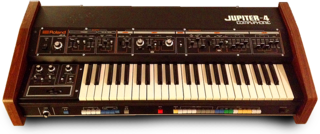
The Roland Jupiter-4 (JP-4) was an analog synthesizer manufactured by the Roland Corporation between 1978 and 1981. It was notable as the company's first self-contained polyphonic synthesizer, and for employing digital control of analog circuits, allowing for such features as programmable memory, voice assignment modes, an arpeggiator, polyphonic portamento and others.

The microKORG is a MIDI-capable digital synthesizer/vocoder from Korg featuring DSP-based analog modelling. The synthesizer is built in such a way that it is essentially a Korg MS-2000 with a programmable step arpeggiator, a less advanced vocoder, lack of motion sequencing, lack of an XLR microphone input, and in a smaller case with fewer real-time control knobs.
The Voyetra-8 (Voyetra-Eight) is an eight voice polyphonic analog synthesizer. Released in 1982 by Octave-Plateau Electronics, it was one of the first analog programmable synthesizers to be rack-mountable and remains one of the most flexible digitally controlled analog synthesizers.
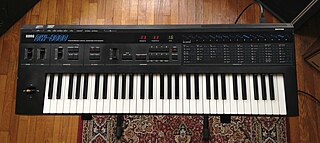
The Korg DW-8000 is a polyphonic hybrid digital-analog synthesizer released in 1985. It blends digital waveforms with an analog filter and amplifier, followed by a digital delay for adding echo effects. It boasts eight-note polyphony and its keyboard is equipped with velocity sensitivity and aftertouch.

The Korg MS2000 is a virtual analog synthesizer produced by the Japanese electronic musical instrument manufacturer Korg.
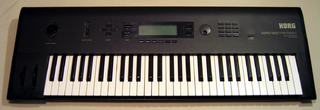
The Korg Wavestation is a vector synthesis synthesizer first produced in the early 1990s and later re-released as a software synthesizer in 2004. Its primary innovation was Wave Sequencing, a method of multi-timbral sound generation in which different PCM waveform data are played successively, resulting in continuously evolving sounds. The Wavestation's "Advanced Vector Synthesis" sound architecture resembled early vector synths such as the Sequential Circuits Prophet VS.

The Oberheim OB•12 is a Virtual Analog synthesizer, designed and realised by the Italian musical instrument manufacturer Viscount, in production between 2000 and 2005.
The Siel DK70 is a synthesizer produced in 1986 by Siel.

The Prophet '08 is a polyphonic analog synthesizer released by Dave Smith Instruments (DSI) in 2007. As with DSI's other instruments, the Prophet '08 uses analog subtractive synthesis. Similar in functionality to the renowned Sequential Circuits Prophet-5 popularized in the 1970s, the Prophet '08 has an all analog signal path; however its envelopes are generated digitally.
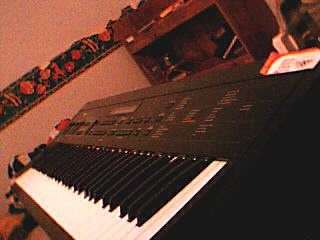
The Korg DS-8 is a digital eight-voice FM synthesizer released by Korg in 1987. Following an agreement with Yamaha for access to its research and development facilities, it was designed using Yamaha components and constructed under a licensing agreement. It introduced an analog-style interface for controlling FM sounds and could play different patches on each of its eight voices, marking it as Korg's first multi-timbral MIDI synthesizer. Accompanying its launch was the Korg 707, a more portable version of the DS-8, lacking digital effects but equipped with strap pegs for keytar performance.

The AX80 is a polyphonic analogue keyboard synthesizer manufactured by Akai Professional in 1984. It was Akai's first venture into the professional electronic musical instrument market. The AX80 used digitally controlled oscillators (DCO) and filter circuitry based on the Curtis Electromusic CEM 3372 integrated circuit. It was marketed as part of a line of project studio equipment called the Akai Music Studio System, which included the S612 digital sampler the MR16 drum machine, the MS08 sequencer, and the MG1212 multitrack tape recorder.

The Korg DW-6000 is a six-voice polyphonic hybrid digital-analog synthesizer released in 1985. It blends digital waveforms with analog filters and amplifiers, and has a chorus effect to create a richer sound. The DW-6000 was quickly succeeded by the DW-8000.

The AX60 is a polyphonic analogue keyboard synthesizer manufactured by Akai Professional in the mid-1980s. It was Akai's answer to the popular Roland Juno series synthesizers. The AX60 uses voltage-controlled analogue oscillators and filter circuitry based on the Curtis Electromusic CEM 3394 integrated circuit.
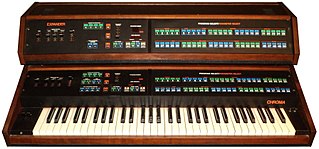
The Rhodes Chroma, initially the ARP Chroma, is a polyphonic, multitimbral, microprocessor controlled, subtractive synthesis analog synthesizer developed in 1979-1980 by ARP Instruments, Inc. just before the company's bankruptcy and collapse in 1981. The design was purchased by CBS Musical Instruments and put into production by their Rhodes Division in 1982 as the Rhodes Chroma, at a list price of US $5295. Rhodes also released a keyboard-less version of the Chroma called the Chroma Expander at a list price of US $3150.

The CZ series is a family of low-cost phase distortion synthesizers produced by Casio beginning in 1985. Eight models of CZ synthesizers were released: the CZ-101, CZ-230S, CZ-1000, CZ-2000S, CZ-2600S, CZ-3000, CZ-5000, and the CZ-1. Additionally, the home-keyboard model CT-6500 used 48 phase distortion presets. The CZ series was priced affordably while having professional features. In the same year Yamaha released their low-cost FM synthesizers, including the DX-21 and Yamaha DX100 which cost nearly twice as much.

The Yamaha DX21 is a digital controlled bi-timbral programmable digital FM synthesizer with a four operator synth voice generator which was released in 1985. It uses sine wave-based frequency modulation (FM) synthesis. It has two FM tone generators and a 32-voice random-access memory (RAM), 32 user voices and 128 read-only memory (ROM) factory preset sounds. As a programmable synth, it enables users to create their own unique synthesized tones and sound effects by using the algorithms and oscillators. The instrument weighs 8 kg (17.6 lbs). On its release, it sold for $795.



















